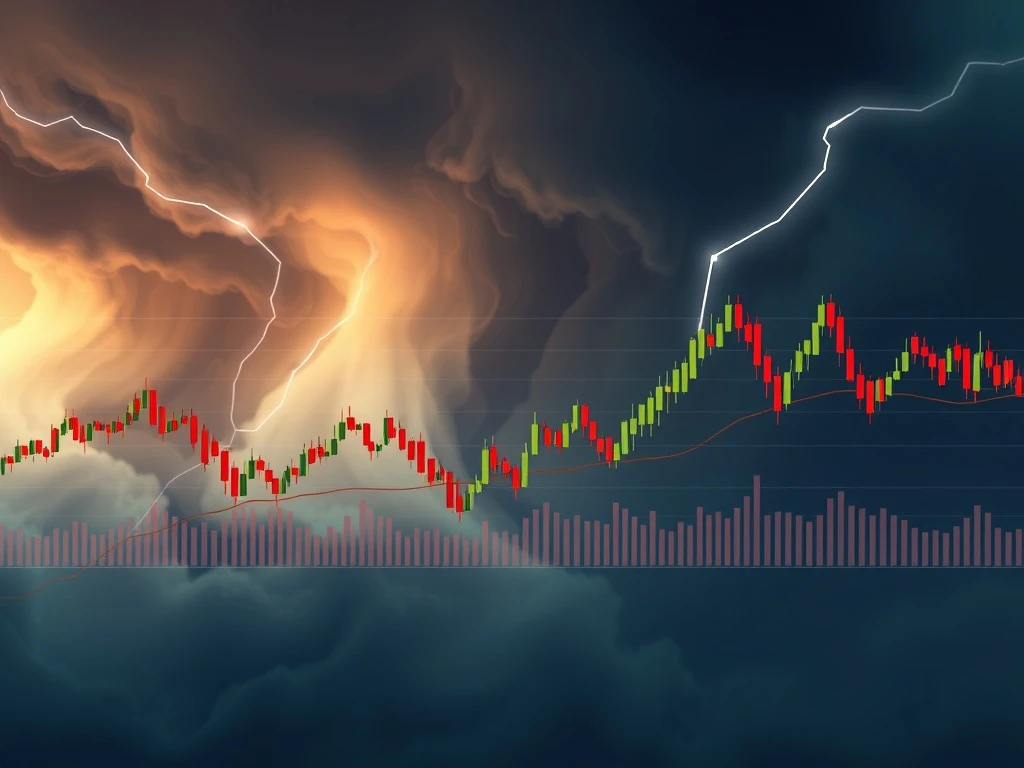Bitcoin Volatility: Unprecedented Squeeze Signals Explosive Price Movement Ahead

The cryptocurrency market is buzzing with anticipation. Bitcoin volatility has recently reached a historic low, a phenomenon often observed before significant price shifts. A key technical indicator, Bitcoin’s Bollinger Bands, has compressed to record-tight weekly levels. This unprecedented squeeze suggests an impending period of intense market movement. Analysts widely predict an inevitable volatility expansion, hinting at major price action on the horizon. Investors are now closely watching for the direction of this anticipated surge.
Understanding Bitcoin’s Bollinger Bands and the Record Squeeze
Bitcoin’s weekly Bollinger Bands are currently the tightest in history. Popular crypto analyst “Mr. Anderson” highlighted this critical observation on X. These bands serve as a technical indicator, revealing both volatility and potential overbought or oversold market conditions. When volatility contracts so tightly, expansion invariably follows. History shows that once this expansion begins, the price typically tests the outer bands quickly. This pattern often signals a decisive move in either direction for BTC price prediction.
Nassar Achkar, Chief Strategy Officer at CoinW exchange, also weighed in. He described the Bollinger Bands’ tight compression as “the calm before a significant volatility storm.” While a final September shakeout toward $100,000 remains a possibility, several factors point to a bullish outcome. Specifically, negative funding rates, strong seasonal trends, and growing institutional exchange-traded fund (ETF) inflows collectively tilt the odds heavily toward an upward surge. “Compression this extreme rarely resolves quietly,” added “Langerius,” founder of Hunters of Web3, emphasizing the potential for dramatic shifts.
Bitcoin’s price chart with technical indicators showing the cryptocurrency’s Bollinger Bands are highly compressed. Source: Mr. Anderson
Historical Precedents: What Past Bitcoin Breakouts Tell Us
Despite some differing views, historical data often provides valuable context. Past instances of extreme Bollinger Band compression have frequently preceded significant Bitcoin breakouts. For example, in early July, Bitcoin’s Bollinger Bands were notably tight. At that time, the asset traded around $108,000. Just days later, Bitcoin experienced a surge in volatility. This led to a significant upside breakout, propelling BTC to its first all-time high over $122,000 by July 14. This example underscores the predictive power of such technical patterns. The indicator tightened again in early September, reaching its most extreme level on the monthly timeframe since BTC’s inception. Related: Bitcoin Bollinger Bands reach ‘most extreme level,’ hinting at explosion to $300K BTC
However, not all analysts agree on the predictive value of these compressions. Glassnode researcher “CryptoVizArt” presented an alternative perspective. They argued that overall Bitcoin volatility has been in decline across all time frames. This trend occurs because Bitcoin (BTC) has matured and grown larger over time. Consequently, the Bollinger Bands have also naturally declined. “This is not a signal, this is not an unexpected structure, this is simply an observation without any real predictive value,” CryptoVizArt asserted. This viewpoint suggests that the current compression might merely reflect Bitcoin’s increasing market capitalization and stability, rather than an imminent explosive move.
Navigating the ‘Uptober’ vs. ‘Septembear’ Debate in Crypto Market Analysis
As October approaches, analysts remain divided on Bitcoin’s next direction. Traders often view October as a potentially bullish month for Bitcoin, affectionately termed “Uptober.” This contrasts with “Septembear,” a historically weaker month. Tony Sycamore, an analyst at IG Group, told Crypto News Insights that Bitcoin “needs more time to correct.” He believes the asset must “continue to work off overbought readings” following its substantial gains this year. This perspective suggests a potential consolidation or minor pullback before any major upward movement. Therefore, caution remains a key theme in some analyses.
Conversely, many analysts highlight historical performance charts from CoinGlass. These charts show a compelling trend: Bitcoin has gained in 10 out of the past 12 Octobers. Furthermore, it has seen gains in 8 out of the past 12 fourth quarters. This historical data strongly supports the “Uptober” narrative. The consistent positive performance during this period offers a hopeful outlook for a bullish end to the year. This historical context provides valuable insight for crypto market analysis. The market awaits a definitive signal to confirm the next major trend. Magazine: Hayes tips ‘up only’ for crypto, ETH staking exit queue concerns: Hodler’s Digest
The record squeeze in Bitcoin’s Bollinger Bands undeniably signals a period of heightened activity. While opinions vary on the immediate direction, the consensus points to a significant price movement. Whether this leads to a dramatic “Uptober” rally or a final correction remains to be seen. Investors should prepare for increased Bitcoin volatility as this critical indicator resolves. Monitoring key on-chain metrics and broader market sentiment will be crucial in the coming weeks. The stage is set for an exciting period in the Bitcoin market, promising significant opportunities for informed traders.










